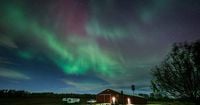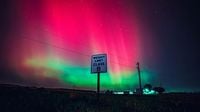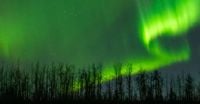Skywatchers across the United States are in for a treat this week as the northern lights, also known as the aurora borealis, are expected to put on a dazzling display. According to the National Oceanic and Atmospheric Administration (NOAA), the phenomenon could be visible on two consecutive nights: late Tuesday, April 15, 2025, into early Wednesday, April 16, 2025, and again on Wednesday night.
The northern lights are caused by charged particles from the sun interacting with Earth's atmosphere. "The Sun continuously produces an outflow of charged particles into the solar system known as the solar wind," NASA explains. When the solar wind reaches Earth, it can interact with Earth's magnetic shield, often depositing and accumulating energy there. When this energy is finally released, much of it rains down on our atmosphere, causing auroras. This week, a severe solar storm has led to increased auroral activity, making it possible for the lights to be seen much farther south than usual.
Since mid-2024, a series of geomagnetic storms has made the auroras visible as far south as northern Florida, coinciding with the sun reaching its solar maximum, the peak of its 11-year activity cycle. This heightened solar activity has resulted in colorful displays being spotted in regions that typically do not experience them. As Shawn Dahl from NOAA's Space Weather Prediction Center noted, "This is going to kind of continue off and on throughout the year."
For those hoping to catch a glimpse of the northern lights, the display is expected to peak on Wednesday, April 16, 2025, possibly stretching across up to 18 states before decreasing to just four states on Thursday, April 17, 2025. The best time to view the aurora is usually between 10 p.m. and 2 a.m. local time, with the most vibrant displays often occurring within an hour or two of midnight.
The states with the best chances of visibility include Alaska, Montana, North Dakota, Minnesota, Wisconsin, Michigan, Maine, Washington, Idaho, Oregon, Vermont, New Hampshire, New York, Pennsylvania, South Dakota, Iowa, Illinois, and Nebraska. This expansive reach is a testament to the strength of the current solar storm.
In Michigan, the northern lights are expected to be particularly visible due to the geomagnetic storm. A strong solar storm earlier this week released large bursts of energy known as coronal mass ejections, prompting space weather forecasters to issue a geomagnetic storm watch. Despite the anticipated cloud cover on Tuesday night, meteorologists suggest that skies will likely be clearer on Wednesday, offering another opportunity for skywatchers.
To enhance the viewing experience, experts recommend finding locations away from city lights, as light pollution can significantly diminish the visibility of the auroras. The aurora will likely appear on the horizon but may rise higher in the sky the further north you are. Skywatchers are encouraged to look northward and be patient, as the lights can take time to appear.
NASA also advises using smartphones to capture the auroras, as these devices often pick up colors and details that may not be visible to the naked eye. With the right conditions, a smartphone camera can reveal stunning images of the lights.
For those in Canada, the northern lights are also expected to be visible from Tuesday to Thursday night across much of the country. The aurora is predicted to be particularly intense, with many locations experiencing a vibrant display. Cities like Toronto, Ottawa, and southern Ontario are expected to have clear views, as the aurora dips southward across Canada.
In summary, this week presents a unique opportunity for skywatchers across the United States and Canada to witness the beauty of the northern lights. With the right conditions, including clear skies and minimal light pollution, the aurora borealis could provide a spectacular show. As the sun continues its active phase, experts predict more opportunities for auroral displays in the months to come, making this a thrilling time for astronomy enthusiasts.
As the excitement builds, skywatchers are reminded to check the NOAA's Space Weather Prediction Center for updates on auroral activity and the best viewing times. With patience and a little luck, many will have the chance to experience this natural wonder firsthand.








